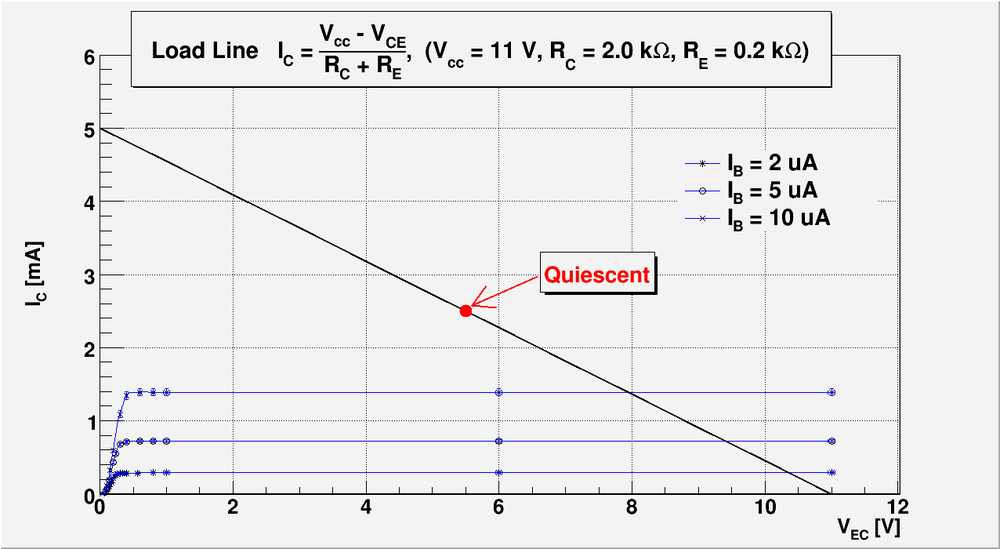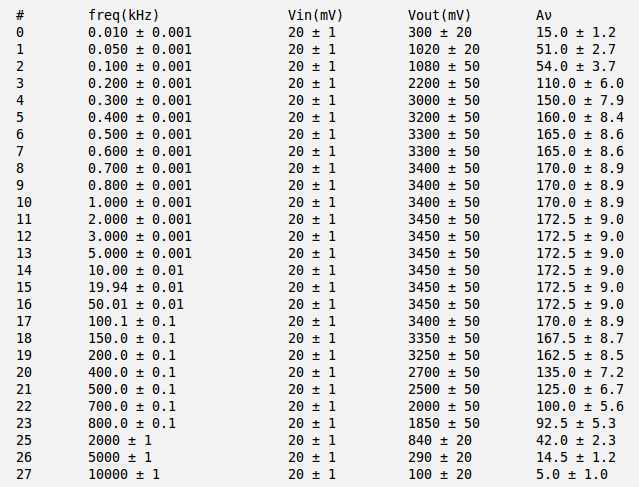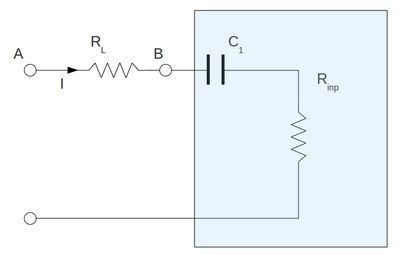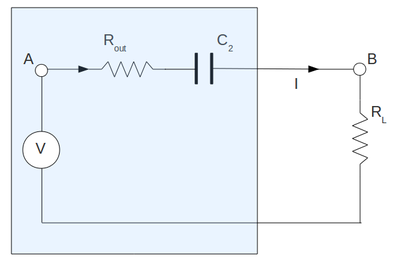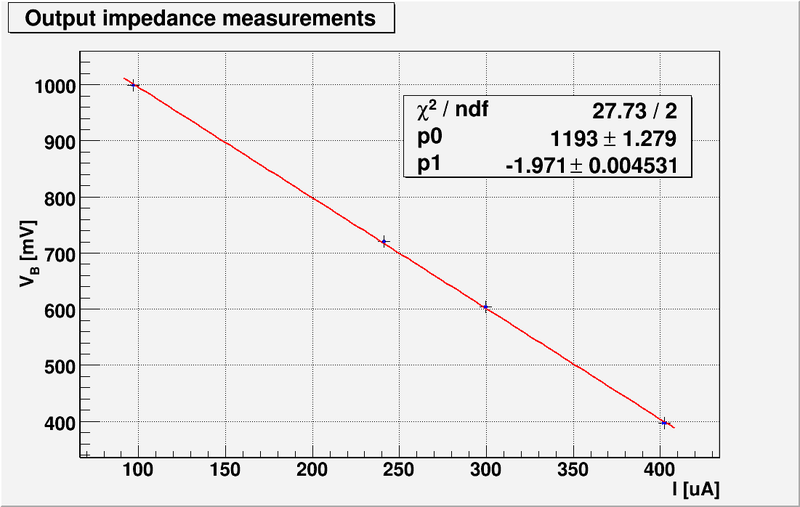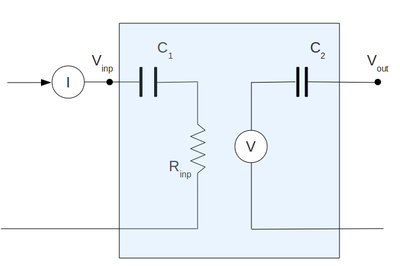Lab 14 RS
The Common Emitter Amplifier
Circuit
Construct the common emitter amplifier circuit below according to your type of emitter.
Calculate all the R and C values to use in the circuit such that
- a. Try and
- b. mA DC with no input signal
- c. V
- d. to prevent burnout
- e.
- f. mA
Let's , and .
The load line equation becomes:
Draw a load line using the -vs- from the previous lab 13. Record the value of or .
On the plot below I overlay the output transistor lines (from the previous lab report #13) and the Load Line calculated above.
My reported values of in lab report #13 was . But this because we have used the approximation because small resistor value was used.
If we will do the accurate calculation of based on my lab report #13 measurements using exact formula:
we will end up with value of :
Set a DC operating point so it will amplify the input pulse given to you. Some of you will have sinusoidal pulses others will have positive or negative only pulses.
I will set up my operating point in the middle of the load line:
, .
Let's calculate all bias voltage needed to set up this operating point. Because the knowing of and is very important for this calculation I did the preliminary set up to measure this quantities. They are the only parameters which depends from transistor. I was able to find:
Now
To set up the above operating point we need to set up .
We have:
.
To get operating point independent of the transistor base current we want
Let's
So
And we can find from Kirchhoff Voltage Low:
.
and Kirchhoff Current Low:
So
I tried to adjust my calculation by varying the fee parameters and to end up with all my resistor values I can easily set up.
Measure all DC voltages in the circuit and compare with the predicted values.(10 pnts)
My predicted DC voltages are: (from the calculation above):
My measured DC voltages are:
Here is very important to set up all resistor values as close as possible to my assumed values.
After many tries and errors I was able to end up with the following values of my resistors:
And my measurements of DC voltages looks like:
All my measurements are in agreement with each other within experimental errors.
I mean here that , and ,
Also all my predicted values are in agreement with my measured DC voltage values except of the fact that my measured instead of as I initially assumed. That gives me the correspondent corrections to . But if I will consider only the one significant sign all my predicted and measured DC voltage values are in total agreement.
Below are my current measurements which I did using millivoltmeter and which are also in agreement with each other and with all my previous calculation:
Measure the voltage gain as a function of frequency and compare to the theoretical value.(10 pnts)
In the table below are my input and output voltage measurements and voltage gain calculation. Here the is the peak-to-peak value of the input voltage, the is the peak-to-peak value of the output voltage, and is the voltage gaine.
Measure and at about 1 kHz and compare to the theoretical value.(10 pnts)
How do you do this? Add resistor in front of which you vary to determine and then do a similar thing for except the variable reistor goes from to ground.
Input impedance measurements
To measure the input impedance of my amplifier I have set up the circulant below. Here I have attached the resistor in-front of capacitor and I replaced all my input internal resistor of amplifier by equivalent resistor . Here I have draw the capacitor only for clearness and it does not included in calculation below. My input signal frequency is
Using Ohm's Law:
and
Below is the table with my measurements and calculation. I did that calculation for several values of
The minimum error for I have for the case .
So my best estimate for is:
Output impedance measurements
To measure the output impedance of my amplifier I have set up the circulant below. Here I have attached the resistor after of capacitor and I replaced all my output internal resistor of amplifier by equivalent resistor . Here I have draw the capacitor only for clearness and it does not included in calculation below.
Here to find out the output impedance we can use the battery method from lab#1. By Kirchoff voltage law:
and
So by graphing the current on the x-axis and the measured voltage on the y-axis for several values of the resistance
we can find the output internal impedance of our amplifier as the slope of the line
Below is the table with my measurements and current calculation:
And below is my plot of output voltage as function of current :
The line equation is
The slope of this line is .
So my measured output impedance is:
Measure and as a function of frequency with removed.(10 pnts)
To measure and as a function of frequency with removed I have set up the following circuit:
Here the box represents the equivalent circuit for my amplifier (with removed ). Here I have draw the capacitor and only for clearness and it does not included in calculation below. To find input current directly I am going to use the meter instead of as I did before. So the input impedance becomes:
and the voltage gain as before
so I will be able simultaneously measure the and as a function of frequency
In the table below are presented my measurements and and voltage gain calculation. Here the is the RMS value of the input voltage, the is the RMS value of the output voltage.
Questions
Why does a flat load line produce a high voltage gain and a steep load line a high current gain? (10 pnts)
If we have a flat load line then by changing a little the input signal (so we will change the and will move up or down in load line) we will change a lot . As the result we have high voltage gain.
If we have a steep load line then by changing a little the input signal (so we will change the and will move up or down in load line) we will change a lot . As the result we have high current gain.
What would be a good operating point an an common emitter amplifier used to amplify negative pulses?(10 pnts)
The operating point should be as higher as possible in the load line so we will have the freedom of moving down in the load line to amplify the negative pulses. But it still has to be in saturation region of transistor.
What will the values of , , and be if the transistor burns out resulting in infinite resistance. Check with measurement.(10 pnts)
What will the values of , , and be if the transistor burns out resulting in near ZERO resistance (ie short). Check with measurement.(10 pnts)
Predict the change in the value of if is increased from 10 to 50 (10 pnts)
Sketch the AC equivalent circuit of the common emitter amplifier.(10 pnts)
Go Back to All Lab Reports Forest_Electronic_Instrumentation_and_Measurement

